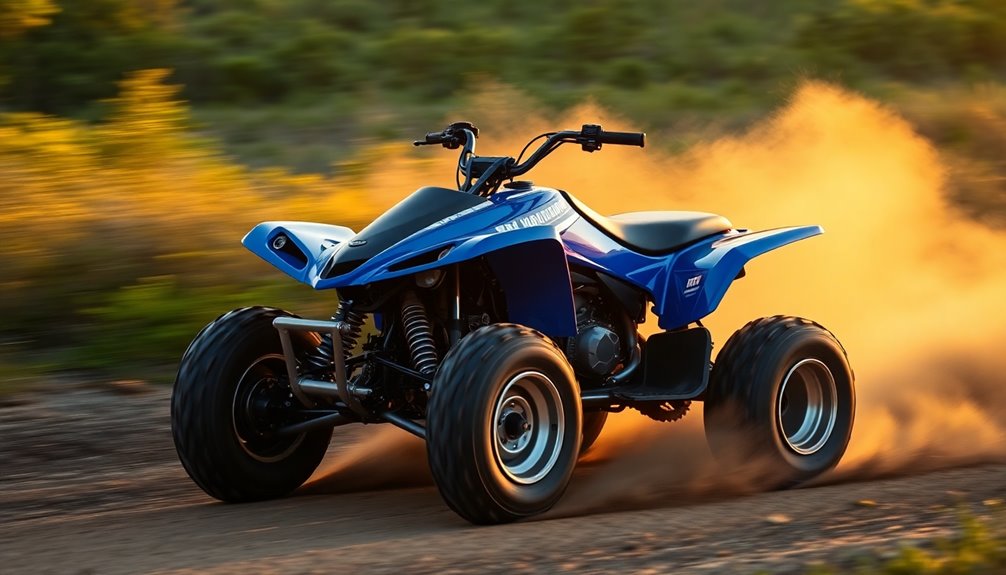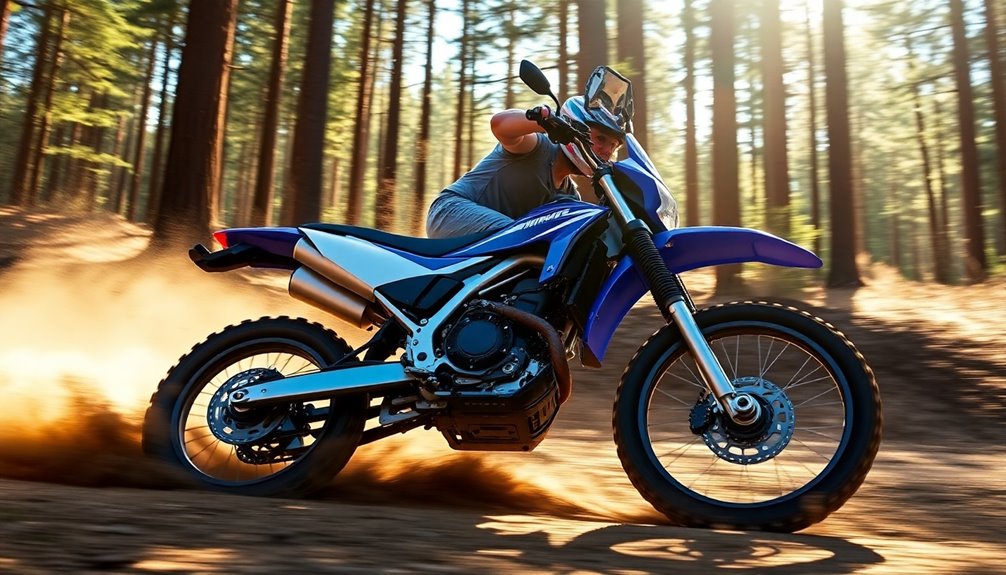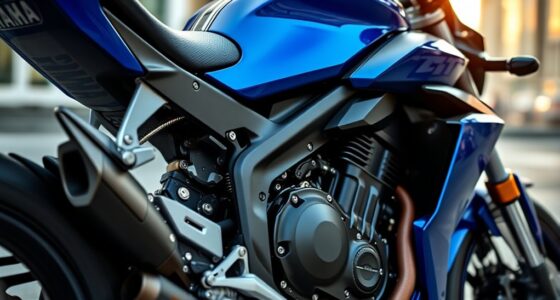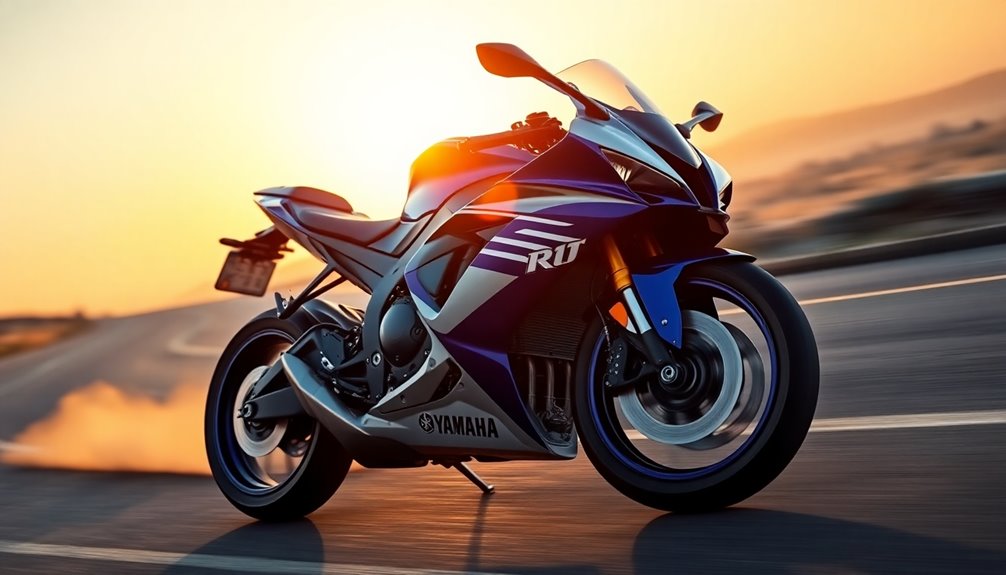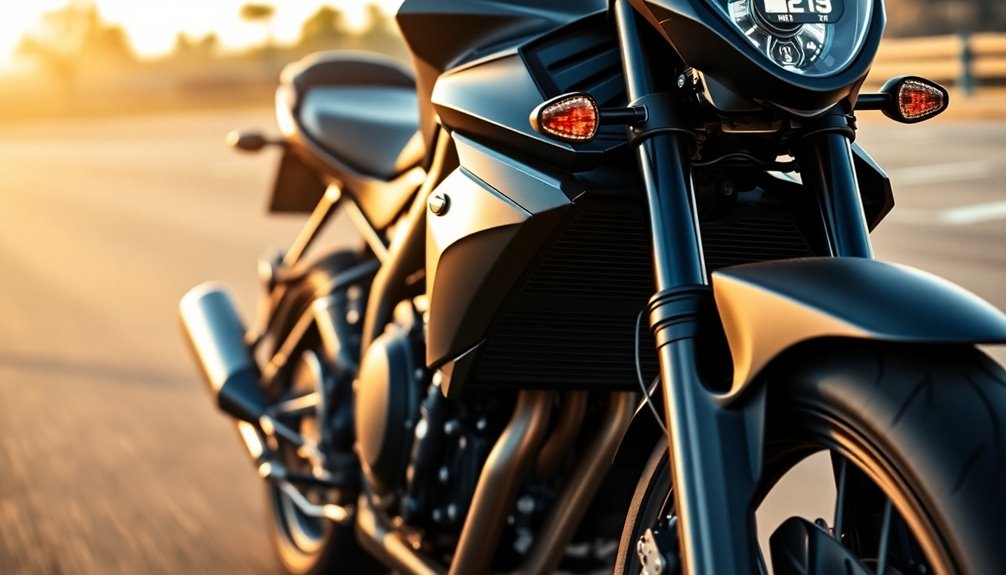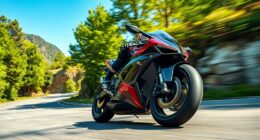The Yamaha Warrior 350 boasts a top speed of around 55 mph, with the potential to hit 63 mph under ideal conditions. Its 348cc four-stroke engine provides solid acceleration and performance, making it a favorite among sport ATV enthusiasts. Though it's considered heavier and less agile than modern models, the classic design and durable steel frame still impress both new and seasoned riders. While some may find the ergonomics lacking for long rides, the Warrior 350 remains a robust choice for trails. Stick around to discover more about its features and capabilities!
Key Takeaways
- The Yamaha Warrior 350 achieves a maximum speed of approximately 55 mph, with peak speeds reaching 63 mph under optimal conditions.
- Powered by a 348cc engine, it delivers 19 horsepower, allowing for quick acceleration from 0 to 30 mph in just a few seconds.
- Its durable steel frame construction enhances stability and performance, making it suitable for various terrains despite some cumbersome handling.
- While it excels in lower RPMs, the ATV's weight can affect agility and comfort, especially on long rides.
- Despite some comfort issues and electrical problems, owners appreciate the Warrior 350's reliable performance and ease of maintenance.
Durable Steel Frame Construction
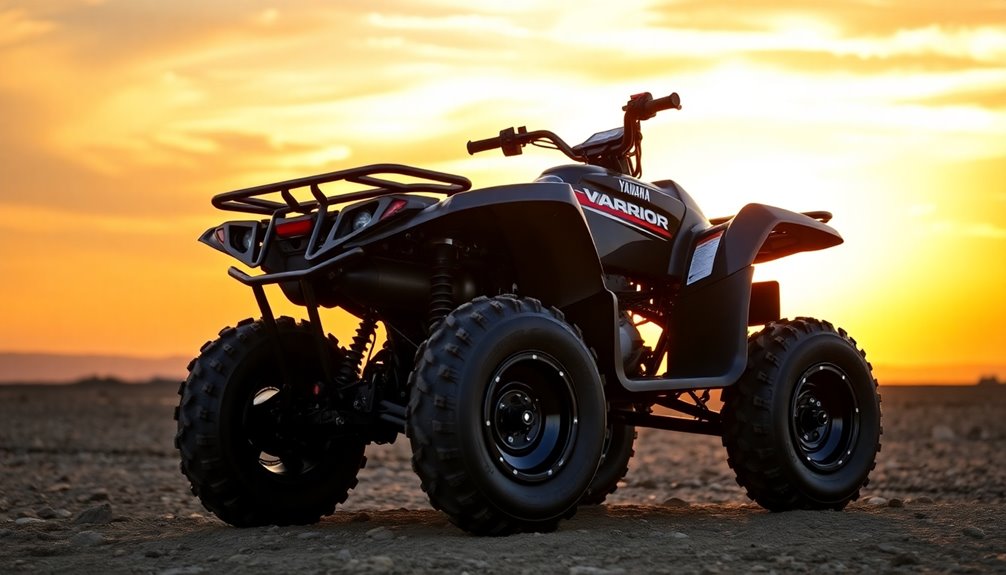
The Yamaha Warrior 350 consistently impresses with its durable steel frame construction. This robust steel frame not only provides exceptional strength but also ensures your ATV can withstand significant wear and tear. Unlike aluminum frames, this steel design offers easier repair options, allowing you to weld or straighten the frame if it becomes bent due to heavy use or accidents. You can identify bent frames through simple measurements and visual inspections, ensuring you catch any issues early.
While the steel construction adds to the overall weight of the ATV, it contributes to stability and a low center of gravity, enhancing your riding experience. The Warrior 350's frame can handle aggressive riding without the constant worry of damage. Additionally, the frame was completely rebuilt during the restoration process, ensuring optimal performance and longevity.
Regular maintenance is essential, though; stripping and repainting the frame can prevent rust and deterioration. You can use aircraft paint remover and sandblasting to refresh the frame's appearance. Additionally, keep an eye on frame components like swing arm bolts and bearings, as these may need periodic replacement.
With proper care, the Yamaha Warrior 350's steel frame can continue to perform reliably, making it a classic choice for any sport ATV enthusiast.
Performance Metrics Breakdown
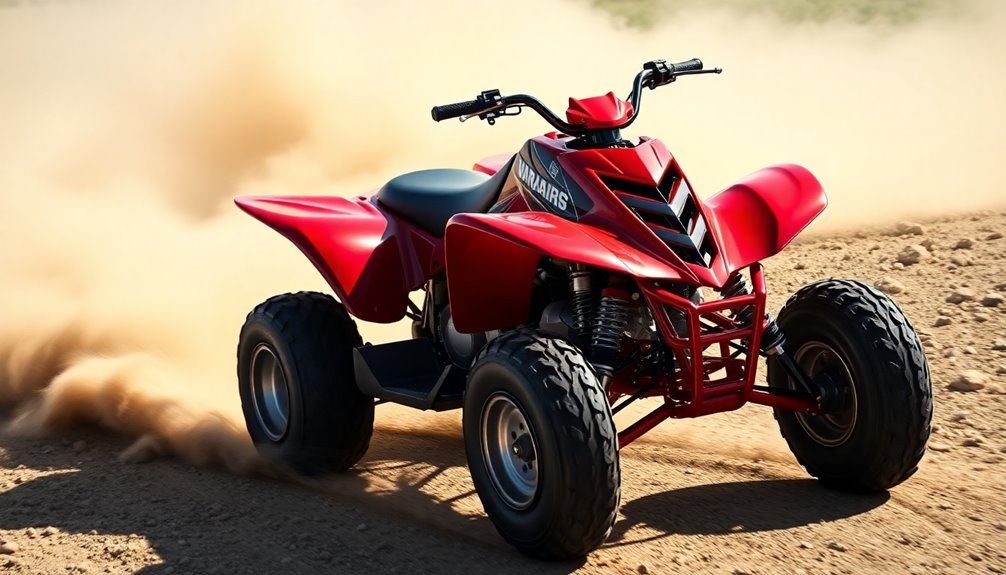
When you push your Yamaha Warrior 350, you might hit a maximum speed of around 55 mph. You'll notice it can accelerate from 0 to 30 mph in just a few seconds, giving you that thrilling rush. Keep an eye on your tire pressure and condition, as these factors play a crucial role in optimizing your performance. The Warrior is capable of reaching a top speed of 63 MPH on flat surfaces under optimal conditions.
Maximum Speed Reached: 55 Mph
Reaching a maximum speed of 55 MPH, the Yamaha Warrior 350 showcases impressive performance metrics for an ATV in its class. This speed, while slightly lower than its peak of 63 MPH on ideal surfaces, still offers a thrilling ride. Factors like weather, rider weight, and the ATV's condition can affect this maximum speed, but in stock form, the Warrior maintains consistent performance.
With its air-cooled, single-cylinder 348cc engine producing 19 horsepower and a 6-speed manual transmission, you're equipped for both speed and control. The dual hydraulic disc brakes provide reliable stopping power, ensuring safety as you push the limits of speed. The Warrior also features a wet weight of 397 lb, contributing to its stable handling on various terrains.
When comparing the Warrior 350 to other models like the Honda 300EX, it holds its ground, often reaching comparable speeds. Additionally, if you're looking to enhance performance, consider modifications such as jetting or upgraded pipes, which can push the top speed beyond stock limits.
To 30 Mph in Seconds
Accelerating from 0 to 30 MPH in just a few seconds is one of the standout features of the Yamaha Warrior 350, making it a favorite among ATV enthusiasts. With its powerful 350cc engine, you'll enjoy quick starts thanks to the low-end grunt that this machine offers. In stock configuration, you can reach 30 MPH in mere seconds, though actual times may vary depending on your weight and the terrain. Smoother trails will allow for faster acceleration, while rougher conditions might slow you down a bit. The Warrior's 6-speed transmission plays a crucial role in achieving optimal acceleration. Its gearing is designed to maximize performance, but you can always tweak it for even better results if you desire. Stock Warrior tops out around 60 mph, ensuring that you have a solid top speed to complement your quick starts. Smooth shifts contribute to quicker times, ensuring you get the most out of your ride. For those looking to enhance acceleration further, consider some modifications like aftermarket exhaust systems or jetting adjustments. These upgrades can significantly reduce backpressure and boost engine performance. Additionally, regular inspections of your ATV can help maintain optimal operation, ultimately ensuring that your ride remains in top shape. Ultimately, whether you're stock or modified, the Warrior 350's acceleration capability is sure to impress on any ride.
Tire Pressure and Condition
Tire pressure and condition are critical elements that can significantly influence your Yamaha Warrior 350's performance on various terrains. Generally, you'll want to keep your rear tires around 5 PSI and the front tires at 6.5 PSI for optimal performance, especially on rocky trails. Higher pressure helps prevent tire damage from sharp objects and reduces the chances of flats. Adjustments can prevent rim damage during hard landings, which is crucial for maintaining control. Additionally, maintaining the correct tire pressure can enhance overall performance by ensuring better traction and stability.
When tackling different terrains, adjust your tire pressure accordingly. For hard cornering or desert racing, higher pressure stabilizes your ride. On the flip side, if you're riding in muddy conditions, a couple of extra pounds can help the tires clear out mud more effectively.
Conversely, lower pressure is ideal for powdery surfaces like sand or snow, as it increases flotation and prevents getting stuck.
Regularly checking your tire pressure before each ride is essential for safety and performance. Using a low-pressure tire gauge ensures accurate readings.
Rider Comfort on Long Trails

Rider comfort on long trails can significantly impact your overall experience, and the Yamaha Warrior 350 falls short in this regard. Its ergonomics leave much to be desired, making long rides less enjoyable. The seat height can be problematic for taller riders, who often need to make adjustments or use tall seat covers for better comfort. The deep saddle position complicates the sit/stand transition, putting unnecessary strain on your knees, especially during aggressive riding.
The suspension isn't up to par either, handling heavy like a tank and making the ATV tiring to ride over long distances. While it performs adequately on tight trails, it lacks the smoothness and agility found in more modern models. The Warrior 350's significant weight compounds the issue, making it cumbersome to maneuver and less balanced on varied terrains. Additionally, the Warrior 350 is known for its reliability and ease of maintenance, which can be a great advantage for those looking for a long-term investment.
Although it has a reverse gear for easier maneuverability, it doesn't enhance long-ride comfort. Overall, the Yamaha Warrior 350 is more suited for short to medium-length rides, where its casual cruising style can shine without wearing you out. For extended adventures, you might want to consider a more comfortable option.
Owner Feedback: Strengths and Weaknesses
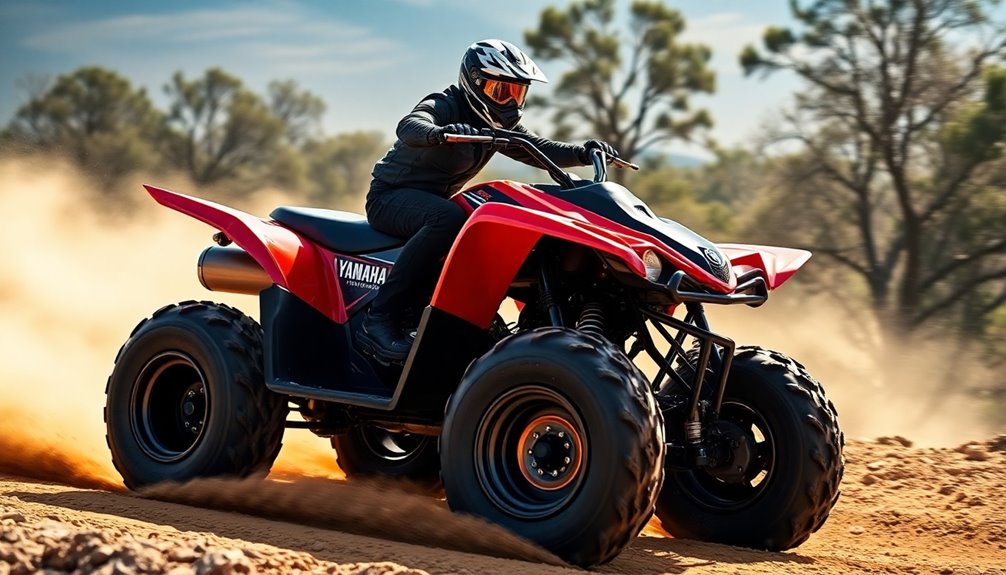
Owner feedback on the Yamaha Warrior 350 highlights a mix of strengths and weaknesses that potential buyers should consider. One of the standout features is its reliability; you can count on it to endure various terrains, from hardpack to swamps. The strong mid-range power makes trail riding enjoyable, while practical features like a six-speed transmission and reverse gear add convenience. Plus, its resale value remains high, thanks to its long production run. Additionally, the Warrior 350 is known for its high parts availability, making maintenance easier for owners.
However, it's not all positive. Many owners find the weight cumbersome, likening the handling to that of a tank, which hinders agility. The suspension is often criticized for providing a rough ride over rugged terrain, and the deep seat position can strain your knees during transitions.
While the engine offers decent performance, it may feel underwhelming in wide-open spaces compared to competitors like the Raptor 350. Additionally, some users report wiring issues that can be frustrating.
Market Position Among Rivals
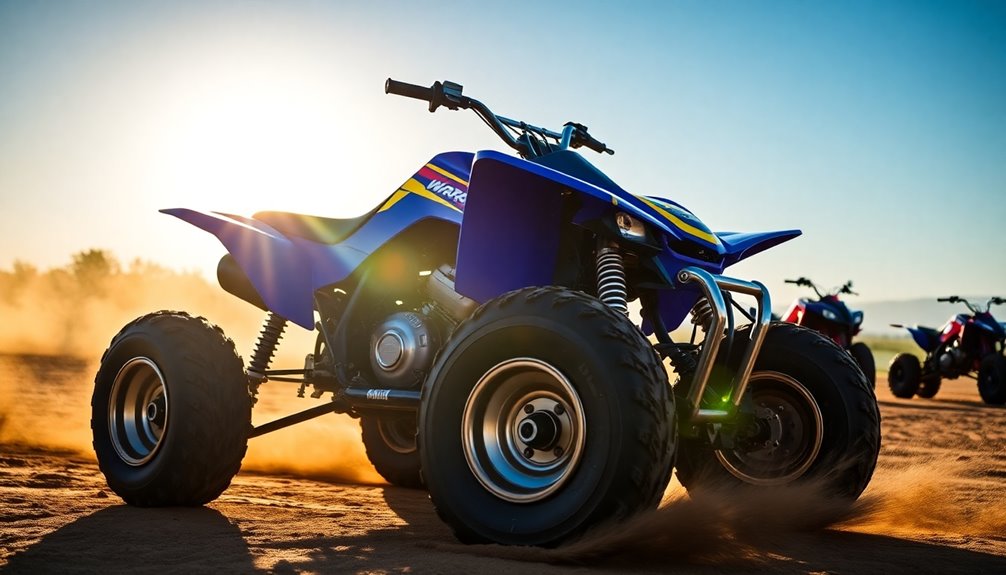
In the competitive world of ATVs, the Yamaha Warrior 350 holds a distinct position among its rivals, particularly when it comes to reliability and affordability. While its air-cooled, SOHC, 2-valve engine delivers smooth power, it doesn't match the straight-line speed of competitors like the Suzuki LTZ 400.
You'll find that the Warrior excels in technical trails, favoring lower RPMs, which helps minimize wheel spin in muddy conditions. However, handling can feel cumbersome, often described as "tank-like," which could be a drawback for some riders. Its ergonomics aren't ideal either, with a low seat that complicates transitions between sitting and standing. Additionally, the Warrior 350 is known for its longevity with minimal maintenance, making it a practical choice for those who desire a dependable quad.
The newer Yamaha Raptor 350 offers better handling and lighter weight, making it a more attractive option for those seeking agility.
On the bright side, the Warrior 350 is a reliable choice that can last for decades with minimal maintenance, although it may require frequent oil changes. With prices ranging from $300 to $3,800, it remains a budget-friendly option.
While its market presence isn't as strong as newer models, the Warrior's durability and affordability continue to attract budget-conscious buyers.
Engine Tuning for Enhanced Performance
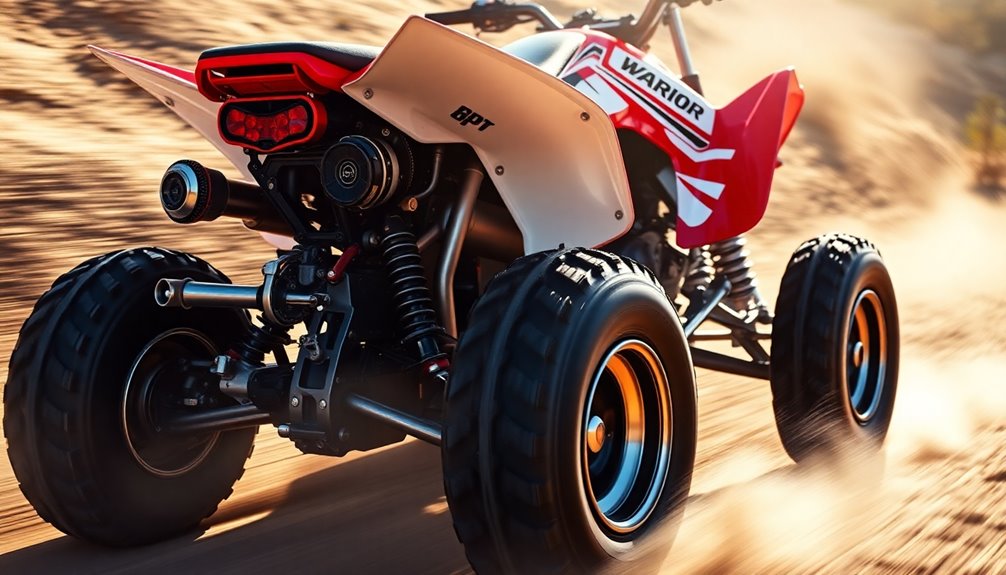
How can you unlock the full potential of your Yamaha Warrior 350? Start by focusing on engine tuning, which can significantly boost performance.
Upgrading your exhaust system is a game changer; consider an HMF Sport Exhaust Pipe paired with an FMF Powerbomb Header for improved airflow. If you prefer a simpler option, a slip-on exhaust can still enhance your ride's low-mid range and top-end speed.
Next, think about camshaft upgrades. Installing a HotCams Stage 2 Cam can increase both power and torque, but remember that cam swaps may require adjustments like new cam bearings. Additionally, consider heavy-duty valve springs if you decide to upgrade to higher performance cams to support the increased demands.
Don't overlook the importance of your carburetor and air intake. Edelbrock carburetors provide better throttle response, while improving your standard Mikuni 36mm carburetor can eliminate performance shortcomings.
Lastly, tweak your gearing for optimal performance. A 14-tooth front sprocket is ideal for achieving better top-end speed, while lower gearing may limit your speed but can improve launch performance.
Always ensure that your modifications are well-tuned to maximize the benefits, and you'll unlock your Warrior 350's true potential.
Cost and Dealer Locations
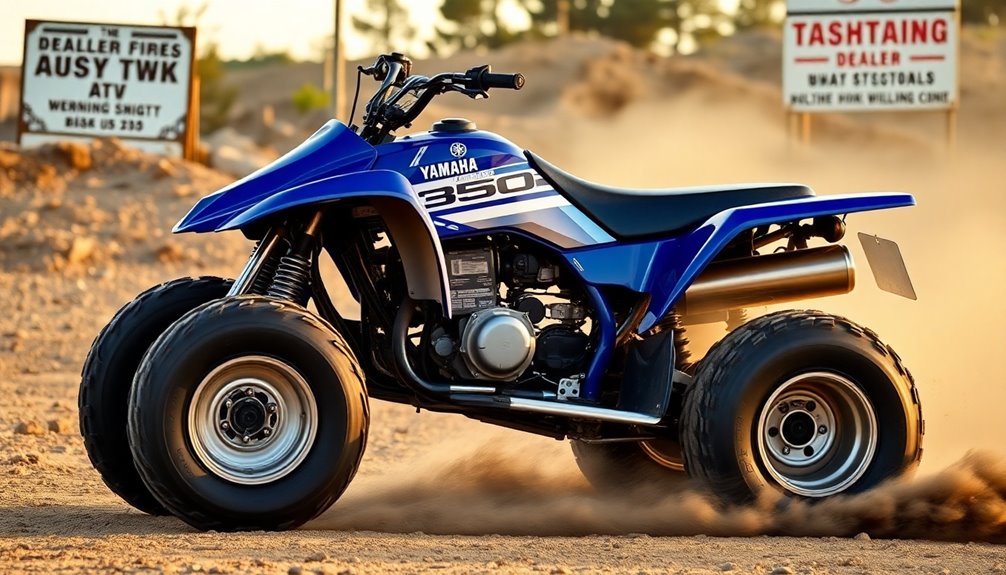
Finding the right Yamaha Warrior 350 at a reasonable price can be an adventure in itself. You'll typically see used models ranging from $1,500 to $3,500, with average prices hovering around $1,400 to $1,600. Occasionally, you might spot a rare deal dipping into the low $1,000s, but those are few and far between. Additionally, the 2002 Yamaha Warrior 350 is notable for its reliability and performance, making it a popular choice among enthusiasts.
When it comes to dealer locations, you've got options. Pre-owned powersports dealerships like Ron Bishop Motorcycles in Escondido, CA, or National Powersports in Pembroke, NH, and Coxsackie, NY, often have units available. You can also check online listings or local dealerships for more choices.
Many dealers offer NH State inspections and even allow test drives before you commit. Some units are thoroughly detailed and tested, while others might be sold as-is, so it's crucial to assess their condition.
Keep in mind that some dealers provide service history reports, which can give you peace of mind. If you're considering delivery, many dealers offer door-to-door services across the continental U.S., making your purchase even more convenient.
Adventure-Seeking Outdoor Enthusiasts
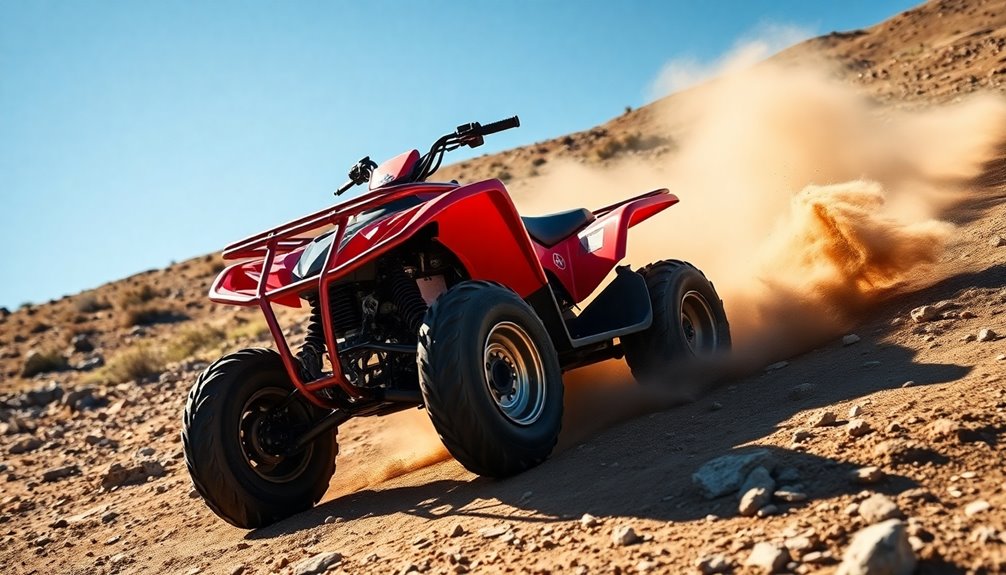
For adventure-seeking outdoor enthusiasts, the Yamaha Warrior 350 stands out as a versatile companion ready to tackle a variety of terrains.
Whether you're navigating rocky trails or racing across sand dunes, this ATV's durable chassis and suspension system ensure you can handle rough conditions with confidence. It's designed for both recreational fun and practical work-related tasks, making it a reliable choice for all your outdoor adventures. Additionally, its robust design aligns with safety gear principles that can enhance your overall riding experience.
The Warrior 350 excels in performance too, powered by a 348cc, 4-stroke engine that delivers 19 horsepower, reaching a top speed of approximately 63 mph on flat surfaces. With a 2-valve, SOHC engine design, it offers a balance of power and efficiency, making it an ideal choice for various riding conditions.
Its 6-speed manual transmission allows for smooth shifting, enhancing your acceleration experience. Plus, with a snorkel kit, you can venture into muddy areas or shallow waters without worry.
Handling is another strength, thanks to its dual A-arm front suspension and mono-shock rear suspension, which absorb shocks and vibrations for a smooth ride.
The wide, supportive seat provides comfort during extended outings, while its short wheelbase improves maneuverability.
Frequent Electrical System Failures
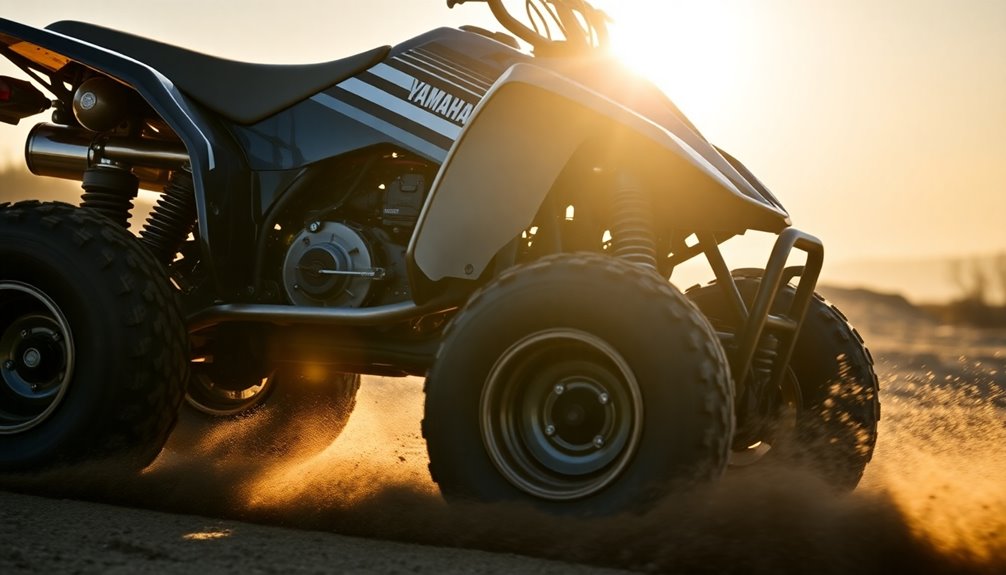
Electrical system failures on the Yamaha Warrior 350 can be frustrating and often leave you stranded during an adventure. You might find yourself unable to start the engine, which often points to critical electrical issues.
Common culprits include incorrect battery installation—hooking it up backwards can create significant damage. Missing or bypassed fuses can cause wiring to overheat, leading to potential burnouts, while improper wiring connections, especially between the CDI and stator, can result in serious electrical failures. It is essential to ensure correct battery polarity to prevent these issues from arising.
You may notice symptoms like carburetor flooding, which can stem from electrical issues, or a lack of spark at the plug, indicating a problem in the ignition system.
If you suspect electrical problems, start by checking for blown fuses, which are typically housed in a rubber holder on the frame. Testing for spark by grounding the spark plug and cranking the engine is also crucial.
Inspect the wire harness for burn marks and use a multimeter for continuity testing between components. Regular maintenance, like replacing blown fuses and ensuring correct wiring connections, can help prevent these frustrating failures and keep your Yamaha Warrior 350 running smoothly.
Robust Brake System Design
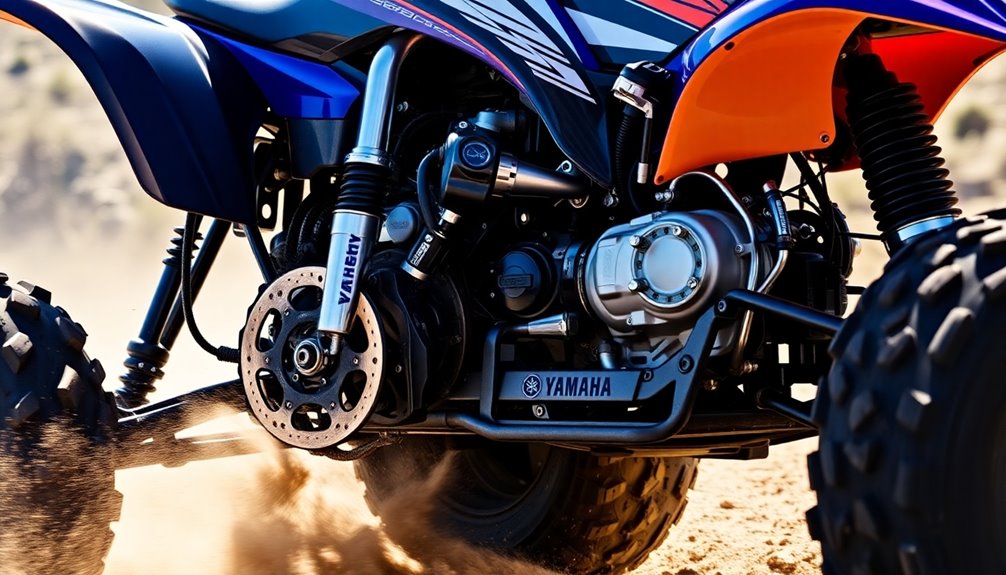
When it comes to off-road performance, a robust brake system design is crucial for ensuring safety and control. The Yamaha Warrior 350 features a brake system that incorporates a mix of materials, from semi-metallic to ceramic pads, giving you options based on your riding style and conditions. Semi-metallic pads offer durability and fade resistance, while ceramic pads provide a good balance of grip and longevity. Additionally, the Warrior uses the same 10×1.25mm lug nut size as many other models, ensuring compatibility with various aftermarket wheels.
Regular maintenance is key to keeping your brakes in top shape. You'll want to watch for wear indicators, like central grooves or soft metal strips, which alert you when it's time for a replacement. Proper fitting is essential; incorrect installation can lead to noisy brakes or vibrations, compromising your ride.
The caliper design also plays a significant role in braking performance. Dual piston calipers, for example, provide enhanced stopping power compared to single piston options. Hydraulic application ensures smooth and effective braking, crucial for navigating tough terrains. Regular checks on caliper alignment and rotor interaction will help maintain optimal performance, ensuring you can tackle any trail with confidence and control.
Classic Design, Timeless Appeal
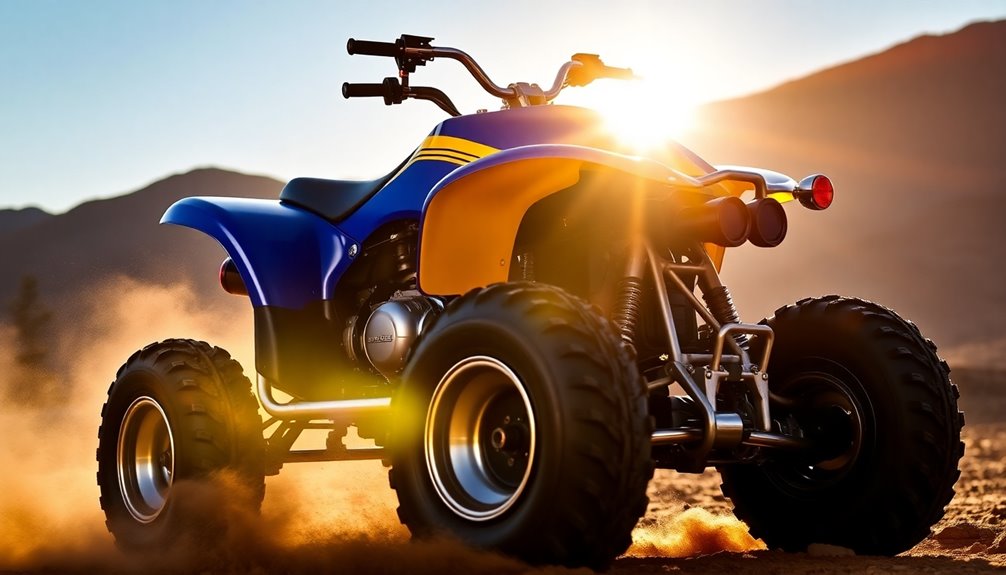
The Yamaha Warrior 350 embodies a classic design that has stood the test of time, appealing to both seasoned riders and newcomers alike. Introduced in 1987, it features a 348cc four-stroke engine, closely related to the Yamaha XT350 motorcycle engine. You'll appreciate the electric starting and recoil backup starter, ensuring you're ready to ride at a moment's notice. The six-speed transmission, complete with reverse gear, enhances its versatility. The Warrior boasts the largest displacement engine in four-stroke ATVs at launch, setting it apart in performance.
This ATV's design isn't just about looks; it's built for both work and play. Whether you're navigating rocky riverbeds or tight trails, the Warrior handles various terrains with ease. Its robust construction means you can rely on it for years without significant issues, making it a favorite among many owners.
While the full suspension provides comfort, keep in mind it's not optimized for aggressive, high-speed riding. However, the wide seat and soft suspension make it a joy on smoother paths.
Frequently Asked Questions
What Is the Yamaha Warrior 350's Top Speed?
The Yamaha Warrior 350 can reach a top speed of around 63 MPH under optimal conditions.
Keep in mind that factors like rider weight, weather, and the ATV's condition can affect this speed.
On flat, even surfaces, you might see speeds ranging between 60 and 64 MPH.
To get the most out of your ride, ensure your ATV's well-maintained and consider any modifications that could enhance its performance.
How Does the Yamaha Warrior 350 Compare to Newer Models?
When you compare the Yamaha Warrior 350 to newer models, you'll notice several differences.
Newer ATVs generally offer more power, advanced suspension, and improved braking systems. While the Warrior 350 has a reliable 348cc engine and a top speed of around 63 mph, modern models often exceed this with larger displacements.
However, the Warrior 350's durability and low maintenance make it a solid choice for those who appreciate classic performance.
What Type of Oil Is Recommended for the Yamaha Warrior 350?
For your Yamaha Warrior 350, you should use JASO-certified oil that's safe for wet clutches.
Depending on the temperature, a viscosity between 10w30 and 20w50 is ideal.
While both synthetic and conventional oils work, synthetic is often preferred for better cooling and cleaning.
Aim for about 2.6 quarts with a filter change, and make sure to regularly check the oil level to ensure optimal engine performance.
Are Aftermarket Parts Available for the Yamaha Warrior 350?
Yes, you'll find a variety of aftermarket parts available for the Yamaha Warrior 350.
You can upgrade your engine with performance camshafts, clutch baskets, and high-flow intake systems.
For the chassis, frame gussets and durable skid plates enhance stability and protection.
Don't forget about drivetrain upgrades, like chain and sprocket improvements.
With so many options, you'll be able to customize and enhance your ride to suit your performance needs perfectly.
What Is the Weight Capacity of the Yamaha Warrior 350?
The Yamaha Warrior 350 has a weight capacity of around 400 pounds.
This means you can comfortably ride it while carrying gear or a passenger, as long as you stay within that limit.
It's important to balance the load evenly to maintain stability and control.
Always check the specific guidelines in the owner's manual for the best performance and safety, ensuring you maximize your riding experience on this robust ATV.
